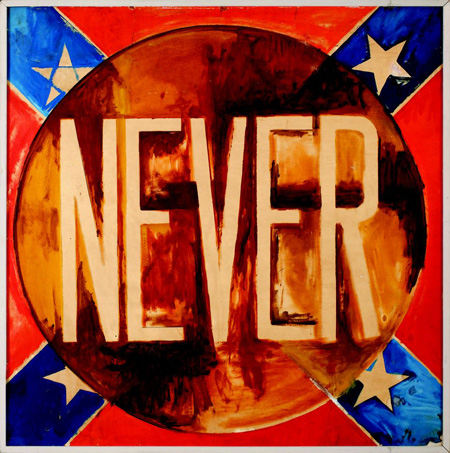
Continuing through May 25, 2013
It is not often that a retrospective can span six decades of a living artist’s oeuvre, and even less often that it can comprise something more than a simple visual timeline. But a happy collaboration between artist G. Ray Kerciu and co-curators Mike McGee and Concepción Rodríguez has produced a tight, informative, and well-organized exhibition. Careful culling is always a must, but even more so for an artist like Kerciu who has not only produced prodigious quantities of art, but in a diverse range of mediums from wood sculpture to stained glass to intaglio prints. Kerciu’s life as an artist - chronicled here from 1957 to 2012 - is not only a fascinating reflection of aesthetic choices that coincide with art history and political upheaval, but also portrays a lifetime of grappling with line, color, and meaning.
Kerciu was catapulted into fame and notoriety in 1962 after he accepted a position to teach at University of Mississippi the same year James Meredith, the first black man to attend Ole Miss, stepped on campus. Kerciu was shocked out of his abstract landscape sensibility when he discovered himself on a campus surrounded by college students proudly bearing black and white buttons emblazoned with the single word, “NEVER,” meaning “Never will we desegregate.” Impassioned and horrified, Kercui began copying the slogans being brandished around him and then, influenced both morally and visually by his stint for the Air Force during the Korean War, Kerciu began creating his own propaganda poster-like paintings based on words and graffiti from the riotous protests. With large block letters against a background of the red and blue stars and bars of the Confederate flag, Kerciu was merely parroting back what he heard and saw in daily campus life, but popular slogans such as IGNORE THE NIGGER WITH VIGOR and WHITE ONLY packed - and continue to pack - a powerful punch, especially when combined with what was considered to be the desecration of the Confederate flag.
Within days of his one-man show at the campus gallery, Kerciu was arrested. A colleague put up his house for bail and Kerciu was released, but not before making it into Time magazine and garnering support and personal recognition from John Steinbeck and Malcolm X. Kerciu recalls being taken away by the police in a big Plymouth with fins that had a real coon’s tail hanging off the antenna. This set of paintings, now called the "Mississippi" series, is the central beating heart of the retrospective, which coincidentally also marks the 50th anniversary of the tumultuous events at Ole Miss. Luckily, the paintings – even aged and deteriorated by poor storage and rat piss as they are – are bold, revealing Kerciu’s remarkably sharp eye for color and composition. Despite this and future ventures into social activism, the bulk of Kerciu’s work is abstract; even the slumped glass sculptures on the wall look like a streams of color, gouache perhaps, running across a canvas.
With fine arts degrees in both sculpture and printmaking, it is in the overlap between object-making and the line-drawing in the artist’s work that demands notice. Beginning with three wood and bronze sculptures from the late 1950’s, the show progresses somewhat chronologically with works grouped by medium and theme. Two videos provide context and commentary. One is of Kerciu himself, interviewed for an oral history project ten years ago; the second is a documentary preview that provides a context for the "Mississippi" series.
Although many of the strongest works in the show are his prints and print-like paintings through the years, Kerciu’s most recent work is a gratifying collection of 20-plus works that provides a sense of culmination and pulls together social struggles with formal issues. Those objects, all made since retiring from Cal State in 2002, take flight, so to speak, in that they escape the canvas and the wall. They are sculptures, but sculpture made with just the thinnest, lightest gestures of wood: thin dowels that become ephemeral lines in space. Tall, spiraling pairs of ladders make DNA helixes and other spindly structures become maquettes for fantastical utopian skyscrapers.
Emerging from a previous obsession with painting pyramids and building solid painted obelisks, the recent series of sculptures capture both a feeling of organic growth and crystalline structure. Kerciu begins with long vertical lines that sometimes have been steamed into flowing curves reaching up into space. Then he adds the horizontal rungs, caging that space and capturing different geometric shapes in the air. The repetition of short lines inside the long lines conveys at once crosshatched pen and ink sketches, computer matrix forms and the exoskeletons of futuristic buildings. They could be architectural models and indeed, Kerciu does wonder out loud what it would be like to walk inside of one.
Just in time for his 80th birthday in October, Kerciu’s retrospective, accompanied by an elegant and comprehensive catalog, makes for an impressive self-proclaimed swan’s song. Although judging from Kerciu’s undiminished appetite for making art, it would be no surprise if these modest wooden structures indeed become life-size frameworks for buildings and public art sculptures before he turns 90.
Published courtesy of ArtSceneCal ©2013
